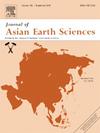Texture and geochemistry of magnetite from the Jinshandian deposit, eastern China: Implications for the formation of high-grade Fe ore in skarn system
IF 2.7
3区 地球科学
Q2 GEOSCIENCES, MULTIDISCIPLINARY
引用次数: 0
Abstract
Iron skarn deposits represent significant sources of high-grade Fe ores, although the mechanisms underlying their efficient enrichment in Fe are not yet fully understood. To investigate the enrichment processes of Fe in the skarn system, texture and geochemistry of magnetite from the Jinshandian Fe deposit located in eastern China were analyzed. Disseminated, friable, and massive ore types are identified at Jinshandian. The friable ore is characterized by loose structure, with minimal or absent cementation minerals interspersed among subhedral to euhedral magnetite crystals. The magnetite at Jinshandian displays significant textural heterogeneity, highlighted by macro- and nanoscale inclusions. Overgrowth and dissolution-reprecipitation (DRP) textures were locally recorded in magnetite. Magnetite grains contains low concentrations of Ti and V, alongside relatively higher Mg, Si, and (Ca+) Al+Mn. Most magnetite grains fall within the skarn field when plotted on geochemical discriminant diagrams. These findings, in conjunction with robust geological evidence, suggest that the Jinshandian deposit originates from intense water–rock interactions. The trace elements in magnetite from the friable ore exhibit similarities to those in disseminated and massive ores, indicating that the friable ore likely formed through a structural softening process that removed soluble cementing minerals (e.g., anhydrite/gypsum and calcite) from the disseminated or massive ore. A comparative analysis of Fe skarn deposits in the Edong district suggests that multiple mechanisms, including accumulation, structural softening, DRP, and superposition processes, may have significantly contributed to the formation of high-grade Fe ores within the skarn system, despite the primary controlling factors varying from one deposit to another.

金山店磁铁矿的结构和地球化学特征:矽卡岩体系中高品位铁矿的形成意义
铁矽卡岩矿床是高品位铁矿的重要来源,尽管其有效富集铁的机制尚不完全清楚。为探讨铁在矽卡岩体系中的富集过程,对中国东部金山店铁矿的磁铁矿进行了结构和地球化学分析。金山店矿石类型分为浸染型、破碎型和块状型。易碎矿石结构松散,半自面体~自面体磁铁矿晶体中穿插少量或无胶结矿物。金山店磁铁矿具有明显的结构非均质性,主要表现为宏观和纳米尺度的包裹体。磁铁矿局部记录了过度生长和溶解-再沉淀(DRP)织构。磁铁矿颗粒含有低浓度的Ti和V,同时含有相对较高的Mg、Si和(Ca+) Al+Mn。在地球化学判别图上,大多数磁铁矿颗粒落在夕卡岩场内。这些发现与有力的地质证据相结合,表明金山店矿床起源于强烈的水岩相互作用。易碎矿石中磁铁矿的微量元素与浸染状和块状矿石中磁铁矿的微量元素相似,表明易碎矿石可能是通过构造软化过程形成的,该过程将浸染状或块状矿石中的可溶性胶结物(如硬石膏和方解石)去除。通过对鄂东地区铁矽卡岩矿床的对比分析,表明易碎矿石具有堆积、构造软化、DRP和叠加等多种作用机制。可能对矽卡岩体系内高品位铁矿的形成起了重要作用,尽管各矿床的主要控制因素各不相同。
本文章由计算机程序翻译,如有差异,请以英文原文为准。
求助全文
约1分钟内获得全文
求助全文
来源期刊

Journal of Asian Earth Sciences
地学-地球科学综合
CiteScore
5.90
自引率
10.00%
发文量
324
审稿时长
71 days
期刊介绍:
Journal of Asian Earth Sciences has an open access mirror journal Journal of Asian Earth Sciences: X, sharing the same aims and scope, editorial team, submission system and rigorous peer review.
The Journal of Asian Earth Sciences is an international interdisciplinary journal devoted to all aspects of research related to the solid Earth Sciences of Asia. The Journal publishes high quality, peer-reviewed scientific papers on the regional geology, tectonics, geochemistry and geophysics of Asia. It will be devoted primarily to research papers but short communications relating to new developments of broad interest, reviews and book reviews will also be included. Papers must have international appeal and should present work of more than local significance.
The scope includes deep processes of the Asian continent and its adjacent oceans; seismology and earthquakes; orogeny, magmatism, metamorphism and volcanism; growth, deformation and destruction of the Asian crust; crust-mantle interaction; evolution of life (early life, biostratigraphy, biogeography and mass-extinction); fluids, fluxes and reservoirs of mineral and energy resources; surface processes (weathering, erosion, transport and deposition of sediments) and resulting geomorphology; and the response of the Earth to global climate change as viewed within the Asian continent and surrounding oceans.
 求助内容:
求助内容: 应助结果提醒方式:
应助结果提醒方式:


